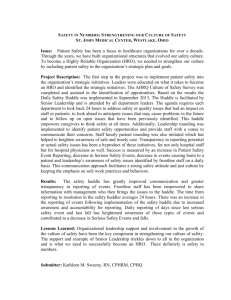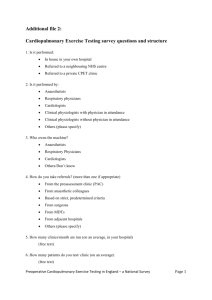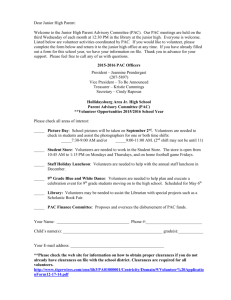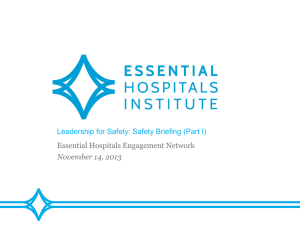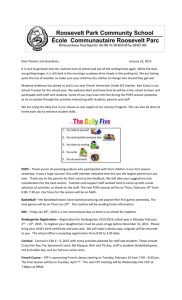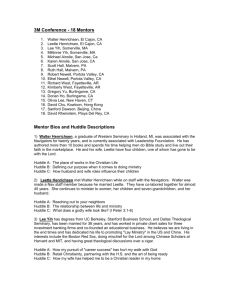ABC Medical Clinic Policies & Procedures SAMPLE Policy
advertisement
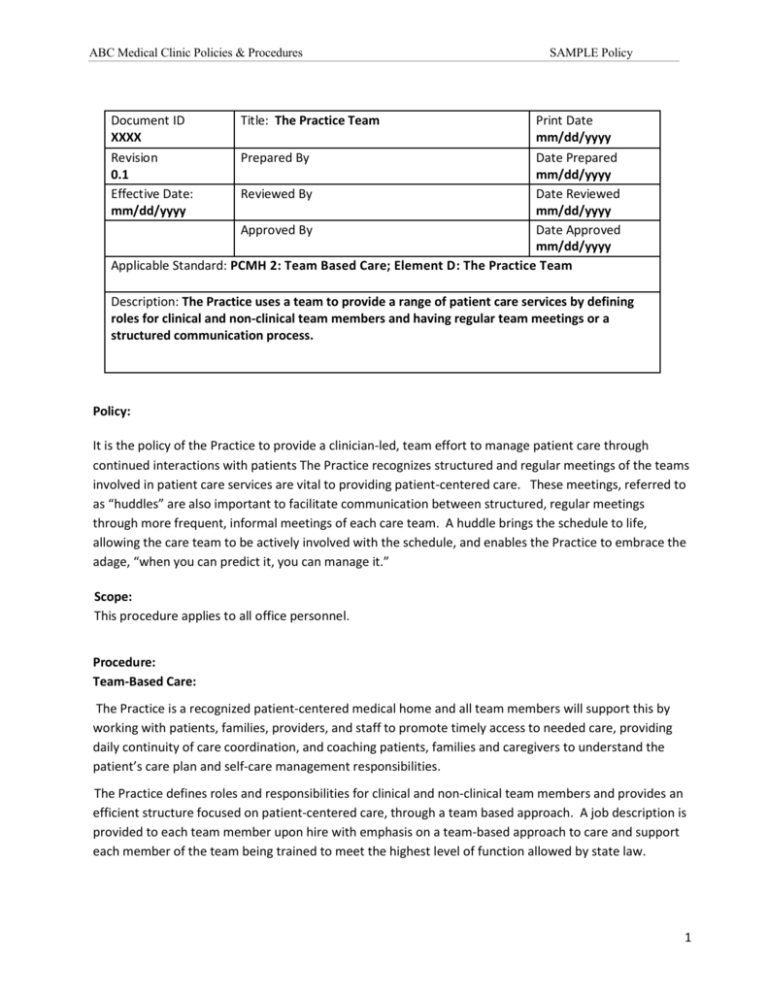
ABC Medical Clinic Policies & Procedures Document ID XXXX Revision 0.1 Effective Date: mm/dd/yyyy SAMPLE Policy Title: The Practice Team Print Date mm/dd/yyyy Prepared By Date Prepared mm/dd/yyyy Reviewed By Date Reviewed mm/dd/yyyy Approved By Date Approved mm/dd/yyyy Applicable Standard: PCMH 2: Team Based Care; Element D: The Practice Team Description: The Practice uses a team to provide a range of patient care services by defining roles for clinical and non-clinical team members and having regular team meetings or a structured communication process. Policy: It is the policy of the Practice to provide a clinician-led, team effort to manage patient care through continued interactions with patients The Practice recognizes structured and regular meetings of the teams involved in patient care services are vital to providing patient-centered care. These meetings, referred to as “huddles” are also important to facilitate communication between structured, regular meetings through more frequent, informal meetings of each care team. A huddle brings the schedule to life, allowing the care team to be actively involved with the schedule, and enables the Practice to embrace the adage, “when you can predict it, you can manage it.” Scope: This procedure applies to all office personnel. Procedure: Team-Based Care: The Practice is a recognized patient-centered medical home and all team members will support this by working with patients, families, providers, and staff to promote timely access to needed care, providing daily continuity of care coordination, and coaching patients, families and caregivers to understand the patient’s care plan and self-care management responsibilities. The Practice defines roles and responsibilities for clinical and non-clinical team members and provides an efficient structure focused on patient-centered care, through a team based approach. A job description is provided to each team member upon hire with emphasis on a team-based approach to care and support each member of the team being trained to meet the highest level of function allowed by state law. 1 ABC Medical Clinic Policies & Procedures SAMPLE Policy The Practice delineates responsibilities for sustaining team-based care, and specifies how care teams align to provide patient-centered care. Specific team units may focus on providing care coordination across and beyond the practice. An organizational chart is used to identify the team structure and staff who will lead and sustain the team. PCMH Practice Team Org. Chart (Source: commonwealthfund.org) The Practice uses standing orders that have been approved by the providers and a written policy is documented. Care team members are trained and assigned to coordinate care for patients/families/caregivers and provide self-efficacy and coaching as needed. Care team members are trained in patient population management and the ability to identify characteristics of a vulnerable patient population. Team Huddles: To promote excellent communication and coordination among the members of the care team, informal meetings of the physician, nurse, health coach, medical assistant, and scheduler who may work in a care team should occur at least daily. These meetings are more effective when held immediately 2 ABC Medical Clinic Policies & Procedures SAMPLE Policy prior to a clinic session (e.g., 7:20 a.m. and 12:50 p.m.) so the team members can jointly review and forecast resolutions to immediate concerns, such as the day’s schedule and assessment of yesterday’s mistakes. The protocol for the huddle is: Team members: Provider, nurse, health coach, medical assistant, and scheduler. *The designated team huddle lead is most often the provider’s medical assistant. Place: Team pod. Time: The huddle may be held in the morning before the day’s clinic starts (e.g., 7:20 a.m.) or on the previous afternoon (e.g. 4:50 p.m.). Alternately, the team may choose to huddle more than twice a day (e.g., 7:20 a.m., 12:50 p.m., and 4:40 p.m.), concentrating on the patients soon to arrive. Participants: Flexibility is encouraged to assure that the information and planning needs of the providers and staff are met. Participants can include the physician and his or her nurse, a medical assistant who assists them, the health coach, and a scheduler (or someone who can communicate with the scheduler). Duration: A short meeting of generally less than 10 minutes to review the upcoming day’s appointment schedule. Content: The huddle focuses on the needs of each patient scheduled that day. Content can include: • Where to fit in any same-day visit requests. • Anticipated no-shows (e.g., a patient who was hospitalized the previous night). • Patients for whom the provider expects to spend more or less time than indicated on the scheduling template. • Patients who need special assistance, such as an interpreter or mobility assistant. • Logistics of any scheduled procedures. • At least once daily, the team members should review mistakes from yesterday and ways to prevent them from occurring again. Technique: Patients’ charts are readied and reviewed per the Practice’s chart preview protocols to evaluate at a minimum whether: • Recommended preventive services had been met. • Consultations or other services that had been ordered at the previous visit were received. • What, if any, special equipment or supplies are needed. Regular team meetings are held to review everyday functions of the Practice, as well as performance evaluations and quality improvement activities. Meetings include clinical staff (e.g., physicians and nurse practitioners) and nonclinical staff. The purpose of these meetings is to discuss practice and staff functions 3 ABC Medical Clinic Policies & Procedures SAMPLE Policy to determine what is working well and what may need improvement. Meeting frequency can vary based on practice needs (e.g., monthly, bimonthly, quarterly), but are a part of the practice’s routine operations. The Practice will involve patients/families/caregivers in the quality improvement process, as well as the Patient Advisory Council (PAC). The Practice involves patients and their families in QI processes through a patient advocacy council (PAC). Ten patients constitute the PAC. Five are chosen each year, with a two-year service period. The patients are chosen based on input from providers and staff members. The Practice strives to include at least one patient from a designated vulnerable population. PAC meetings are held four times annually during a time agreed upon by PAC members. At each PAC meeting, at least two QI processes are included on the agenda to gather feedback. The CO and members of the Administration are present at all PAC meetings. Quality Control: The Practice monitors the policy and procedure in the following manner: 1. Staff maintains current performance evaluations and reviews quality improvement measures. 2. Staff ensures that all parties (patients, families & caregivers) share a role in the quality Improvement process and have the opportunity to advise the Practice's advisory council. 3. Periodic monitoring to determine whether team huddles are deal by all care teams prior to each clinical session and are kept to 10 minutes or less. 4. Annual monitoring of whether the charts for patients scheduled in the clinical session have been previewed and summarized by the start of each daily team huddle meeting, with a goal of 100%. 5. Annual assessment of the structure, logistics, agenda, and overall value of the PAC. The chief medical officer and the administration confer annually for this discussion, which may be in concert with the meeting to decide on the new members of the PAC. Revision History: Revision 0 Date Description of changes Requested By mm/dd/yy Initial Release 4 ABC Medical Clinic Policies & Procedures SAMPLE Policy 5

